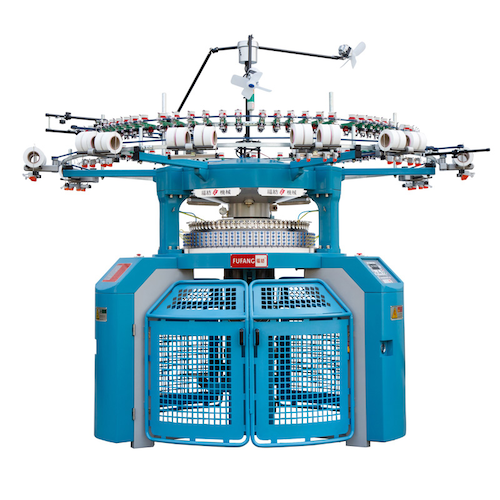
Basic operating knowledge of circular knitting machines—machine operating procedures-1
2024-04-12 20:00Basic operating knowledge of circular knitting machines—machine operating procedures
1. Threading yarn
(1) Mount the package yarn on the creel, find the yarn end and pass it through the yarn guide magnetic eye on the creel.
(2) After passing the yarn through the two tensioner devices, guide it down and thread it into the yarn feeding wheel.
(3) Thread the yarn through the automatic stop device in the middle, and introduce it into the magnetic eye of the yarn feeding port of the main body. Pull the yarn end out and introduce it into the needle hook.
(4) Wind the yarn around the yarn feeding wheel several times. At this point, the yarn threading work of a yarn feeding port is completed.
(5) Follow the above steps to complete other yarn feeding ports.
2. Open cloth
(1) Improved cloth opening method (applicable to single-sided machines)
A. Preparation
Disable active yarn feeding.
Open all closed latches.
Remove any loose yarn ends and keep the needles completely fresh.
Remove the fabric support frame from the machine.
B. Opening work
Insert the yarn into the needle hook through each yarn feeding port and pull it to the center of the needle barrel.
After each yarn is threaded, integrate all the yarns into one bundle. Under the premise of feeling that the tension of each yarn is uniform, tie the yarn bundle and pass the knot through the winding shaft of the winding machine. , tied tightly to the rolling stick.
Start the machine at "slow speed" to check whether all knitting needle latches are open and whether the yarn feeding condition is normal. If necessary, use a brush to assist in yarn feeding.
Unwind the fabric at low speed. After the fabric is long enough, install the fabric support frame and pass the fabric evenly through the winding shaft of the winding machine to unload the fabric faster.
When the machine can knit normally, enable the active yarn feeding device to participate in yarn supply, and use the tensioner to adjust the tension of each yarn to be even, and then it can be knitted at high speed.
(2) Traditional covering method (applicable to double-sided machines)
The double-sided machine does not have a sinker, and its knitting unlooping is all accomplished by the tension of the winding device. Therefore, it cannot directly thread the yarn to open the fabric. Instead, a section of completed gray fabric must be hung on the needle hook, and then the gray fabric must be The cloth can be opened by rolling and pulling, which is called the cloth wrapping method. The specific operations are as follows:
A. Preparation
Disable active yarn feeding.
Open the latches of all knitting needles.
Remove loose and floating yarn ends to make the knitting needles completely fresh.
Find a piece of fabric with a similar weave to the original fabric, it is better if the weave is slightly looser.
B. Covering work
Put the cloth on the outside of the cloth frame, starting from the opposite ends, so that the cloth is evenly distributed around the lower needle barrel.
Gently hold the cloth end with your hand and send it upward from the inside of the lower needle cylinder. Hold the yarn hooking needle with the other hand, hook the fabric from the gap between the upper needle plate and the lower needle cylinder, pull it out, and hang it on the needle hook of the lower needle cylinder.
Fold the excess cloth in the opposite direction back to the inside of the lower needle barrel and press it down.
Use the brush to feed the new yarn loop into the needle hook. Note that the needle latch must be open and flexible at this time, and no yarn can stick to the clamping groove of the knitting needle and the cloth cannot be removed.
Press the slow button to start the machine, and use the above method to make other knitting needles take yarn. In this cycle, the cloth that was originally hung on the machine will be pulled down.
Continue this operation until a new yarn loop appears on the needle cylinder. Check whether the yarn feeding at each yarn feeding port is normal and adjust the position of the yarn feeding port appropriately.
Put the cover that was originally pulled downwards by hand into the winding shaft of the winding machine, so that the winding machine can automatically wind up. Note that the pulling force should not be too large at this time to prevent the new yarn loop from breaking.
Adjust the speed to make the machine run at low speed, and check whether all needle latches are open.
When the machine can knit normally, adjust the tension of the winding machine and spray a small amount of needle oil on the knitting needles to speed up the operation.
Let the active yarn feeding device take part.
3. Change yarn
(1) Remove the empty yarn bobbin and tear off the yarn.
(2) Take a new yarn cone, check the yarn cone label, and verify whether the batch number matches.
(3) Place the new yarn cone into the yarn holder, take out the yarn end, and pass it through the yarn guide magnetic eye on the creel, making sure that the yarn comes out smoothly.
(4) Knot the old and new yarn ends. The knot should not be too large.
(5) Since the probability of yarn breakage increases after changing the yarn, it is necessary to switch to slow speed operation at this time. Observe the knot weaving situation to prevent floating cloth. Only when everything is normal can you knit at high speed.

